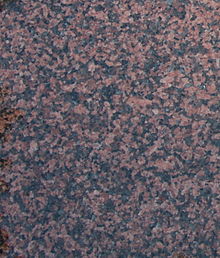Quimbra
Quimbra is a Swedish granite that is quarried on the southeast coast of Småland in quarries between Oskarshamn and Västervik and near Flivik . It originated 420 million years ago in the Precambrian .
Granite types
There is the Quimbra Red (also Quimbra Röd or Mahogany ), which contains more red and the Quimbra Gray ( Quimbra Gray-Red ) more gray-red color components.
Geology and occurrence
The occurrence of Quimbra is in the Baltic Shield , which was formed in the Precambrian. This shield extends over almost all of Sweden and Finland and over a part of Russia bordering southern Finland.
The gneiss region and the black vein rocks (such as the Black Swedish ) are located in southern Sweden, while the granites are located on the coast of southern Sweden.
The mahogany type of granite is mined near Flivik.
Rock description and mineral inventory
Quimbra is a medium-grain rock whose grain size is relatively uniform. Quimbra consists of 60 to 65% red potassium feldspar , 30% blue quartz and 8% black biotite . As an accessory , this natural stone contains pyrite and titanite . In Quimbra Gray
The granite types of the Quimbra hardly vary in their appearance and color.
use
Quimbra was exported to Germany from the 1970s, later to other European countries and overseas.
This natural stone is mainly used in construction, in interior and exterior architecture as stair and floor coverings and facades. It is also used as a vanity in bathrooms and as a worktop in kitchens .
In Germany, Quimbra can mainly be found as a tomb in cemeteries.
Quimbra is frost-resistant and polishable.
See also
literature
- Karlfried Fuchs: Natural stones from all over the world, discover, determine, use. Vol. 1. Munich (Callwey) 1997, ISBN 3-7667-1267-5 .
- Friedrich Müller : INSK compact. The international natural stone index for the current market . Sheet 1.2, Quimbra Röd. Ebner Verlag, Ulm 1977
Web links
- Image from Quimbra Grau-Rot , natursteinonline.de, accessed on May 28, 2011
- Image from Quimbra Rot , natursteinonline.de, accessed on May 28, 2011
Individual evidence
- ↑ Stone from Flivik , emmabodagranit.se, in English, accessed on May 28, 2011
- ↑ Fuchs: Natursteine, sheet 68 (see literature)
Coordinates: 57 ° 32 ′ 23.8 " N , 16 ° 34 ′ 35" E
